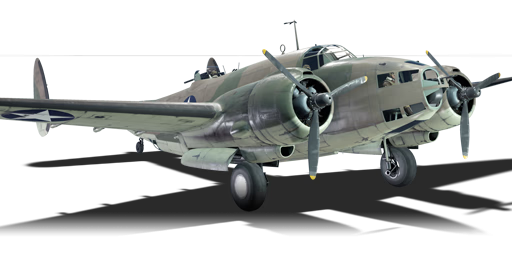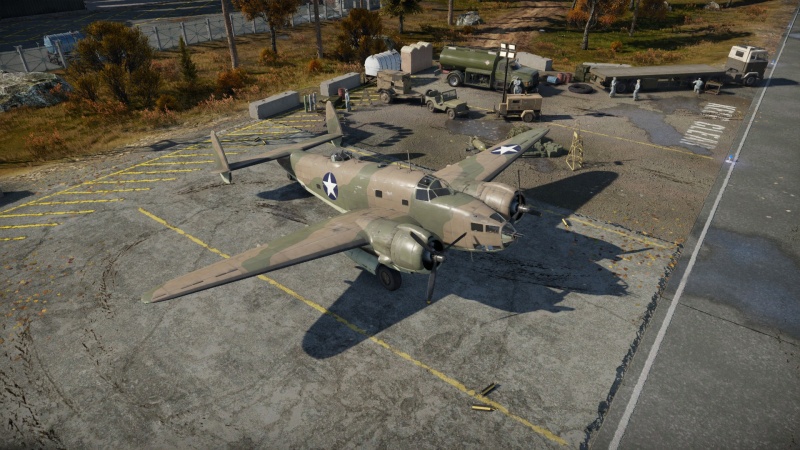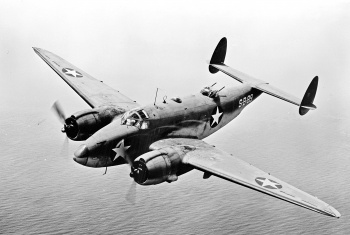B-34
Contents
Description
The Lockheed Ventura was a military version of the Model 18 Lodestar passenger aircraft. L-108, as it would be temporarily named, was developed as a successor to the Lockheed Hudson, which saw massive use in the Royal Air Force. The Ventura was intended to be a slightly larger, more powerful aircraft compared to the Hudson. At this time, the B-34 designation was not given. The RAF became the primary user of the Ventura until the Ventura IIA which was given the designation "B-34". It was delivered under the Lend-Lease Act, and thus were given both RAF and US serial numbers. Soon after, they were put into service by the United States Army Air Force and received the name "Lexington". B-34s were largely relegated to training, and most never saw active combat in US service. In fact, they were given the designation "RB-34", which states that it was not allowed to be used in combat.
Introduced in Update 1.65 "Way of the Samurai", the B-34 is a medium-sized bomber and is a significant improvement over the Hudson. The B-34 features a better payload of up to 2,500 lbs of bombs and more defensive armament. In addition, the B-34 also has two 12.7 mm machine guns and two 7.62 mm machine guns for offensive use, which can also be used against enemy aircraft. Thanks to its structural limit of over 630 km/h (391 mph), B-34 players can easily dive to bases to quickly drop bombs and either attack enemy fighters or ground targets. It can also defend itself with a twin 12.7 mm machine gun turret and a twin 7.62 mm machine gun turret. Both have ample ammunition as well.
General info
Flight performance
While flying the B-34 you can expect manoeuvrability and speed like few other bombers. Considering you are just a Rank II aircraft you have a good acceleration and max speed, which will allow you to get out of difficult situations, even being able to outrun some lower BR fighters, although never forget to use your turrets to shake enemies off your tail.
Your speed and climb ratio will be superior to most enemy bombers you face, therefore making it an easy task to intercept them. Although try to always keep it under 4,500 m as your engines aren't meant for high altitudes, and you will become a big and sluggish target for any fighter around. As a last defensive manoeuvre in this bomber it is possible to trade some altitude for speed in order to escape from a threat, however keep it at a max speed of 610 km/h IAS since going faster than that will completely lock your surface controls and eventually get you killed.
Given its surprising turn rate and speed for a bomber, mixed with a good offensive power, when used wisely you can successfully intercept enemy aircraft that aren't yet aware of your position, as well as support your allies if you see an enemy tunnel vision-ed on them, however don't fool yourself into a dogfight since every fighter will outturn you sooner than later.
| Characteristics | Max Speed (km/h at 4,572 m) |
Max altitude (metres) |
Turn time (seconds) |
Rate of climb (metres/second) |
Take-off run (metres) | |||
|---|---|---|---|---|---|---|---|---|
| AB | RB | AB | RB | AB | RB | |||
| Stock | 509 | 496 | 9500 | 28.3 | 29.3 | 8.5 | 8.5 | 480 |
| Upgraded | 572 | 539 | 25.8 | 27.0 | 16.7 | 12.0 | ||
Details
| Features | ||||
|---|---|---|---|---|
| Combat flaps | Take-off flaps | Landing flaps | Air brakes | Arrestor gear |
| ✓ | ✓ | ✓ | X | X |
| Limits | ||||||
|---|---|---|---|---|---|---|
| Wings (km/h) | Gear (km/h) | Flaps (km/h) | Max Static G | |||
| Combat | Take-off | Landing | + | - | ||
| 633 | 235 | 328 | 313 | 235 | ~7 | ~4 |
| Optimal velocities (km/h) | |||
|---|---|---|---|
| Ailerons | Rudder | Elevators | Radiator |
| < 260 | < 290 | < 320 | > 337 |
Survivability and armour
- 12 mm steel - in front of pilot
- 12 mm steel - behind pilot
- 12 mm steel - bulkhead behind cockpit
- 12 mm steel - tail bulkhead
- 20 mm steel - front of dorsal turret
Modifications and economy
Armaments
Offensive armament
The B-34 is armed with:
- 2 x 12.7 mm M2 Browning machine guns, nose-mounted (250 rpg = 500 total)
- 2 x 7.62 mm Browning machine guns, nose-mounted (375 rpg = 750 total)
Suspended armament
The B-34 can be outfitted with the following ordnance:
- 7 x 250 lb AN-M57 bombs (1,750 lb total)
- 4 x 250 lb AN-M57 bombs + 3 x 500 lb AN-M64A1 bombs (2,500 lb total)
- 1 x 2,216 lb Mk.13-6 Case torpedo
Defensive armament
The B-34 is defended by:
- 2 x 12.7 mm M2 Browning machine guns, dorsal turret (400 rpg = 800 total)
- 2 x 7.62 mm Browning machine guns, ventral turret (1,000 rpg = 2,000 total)
Usage in battles
In the hands of an experienced player, the B-34 can be one of, if not the deadliest aircraft of its tier. While being in the bomber line of the tech tree, the B-34 is better suited for use as a frontline bomber, bomber interceptor, and even a heavy fighter in some situations. If played in a bombing role, try to get in low and entice enemy fighters into chasing you while you go for your bombing targets; your powerful 12.7 mm turret will make quick work of most enemies you'll encounter at its tier. If played as a bomber interceptor, aiming for crucial parts of the target's aircraft (Engine, wings, cockpit, Etc.) with your robust offensive armament will take down enemy bombers quickly and efficiently. Using the B-34 in a heavy fighter role will require the use of your flaps, so make sure to use them when appropriate; as the B-34 has poor energy retention. Head-ons with enemy fighters are ill-advised, as your pilot is quite susceptible to frontal enemy fire as well as your engines that will take damage quite easily.
Your deadliest enemies will be aircraft with heavy machine gun or cannon armament (P-400, LaGG-3-8, Spitfire Mk IIb, etc.) It is advised to get familiar with using the 12.7 mm dorsal turret while doing evasive manoeuvres using flaps for dealing with them quickly before they can do major damage to your aircraft. If they dive on you and fly in front of you for a bit, try to damage them with your frontal armament. Do not let anyone get under your belly, as it is a huge weak spot that knowledgeable players will exploit. In the hands of a skilled pilot, however, you will have no problem going for engine shutdowns or pilot snipes that will quickly send your foes back to the hangar.
Manual Engine Control
| MEC elements | ||||||
|---|---|---|---|---|---|---|
| Mixer | Pitch | Radiator | Supercharger | Turbocharger | ||
| Oil | Water | Type | ||||
| Controllable | Controllable Not auto controlled |
Controllable Not auto controlled |
Controllable Not auto controlled |
Separate | Controllable 2 gears |
Not controllable |
Pros and cons
Pros:
- Reasonably effective armament consisting of 2 x 7.62 mm Brownings and 2 x 12.7 mm Brownings that are nose-mounted
- Durable airframe for its BR
- Reasonably effective defensive armament with good coverage on the rear section of the plane
- The dorsal turret can swivel 360 degrees and even fire at targets towards the nose of the plane
- Can provide initial cover for other bombers until fighters reach their altitude
- Blazing fast top speed compared to other medium bombers
- Reasonably large payload capacity
Cons:
- The belly of the aircraft is a massive blind spot in the aircraft's defence
- Poor climb rate and energy retention
- For the most part, the offensive armament will only be useful in attacking enemy bombers, ground targets, or engaging fighters head-on, as the plane is not manoeuvrable enough for any real dogfighting of any kind
- Steel construction makes this plane particularly heavy, and a small payload limits this plane's ability to be used as a tactical or strategic bomber
- The elevator can be shot off by an enemy plane easily, causing it to become uncontrollable, although it may still be controllable by operating flaps or adjusting engine power in some cases
- Poor manoeuvrability at lower speeds
- Landing gear is quite weak; breaks at >235 km/h
History
In the beginning of the war, the British were looking for a medium-ranged anti-submarine warfare and patrol aircraft to support the existing Avro Anson. The Lockheed company sent a drawing of their Model 14 Super Electra civilian airliner. The British Purchasing Commission saw the design and asked Lockheed to make modifications to the Model 14. Modifications included two fixed forward-firing Browning 7.7 mm machine guns in the nose. There was also the installation of a Boulton Paul dorsal gun turret with two Browning machine guns. Some models had beam guns installed, while others had different engines or propellers. It was renamed the Lockheed Hudson. The Hudson served as the basis for the B-34 (Ventura, originally). It was developed from the Lockheed Model 18 Lodestar, another civilian airliner. The Ventura was first delivered to the British in 1942. Originally, it was used for daylight raids but, like other RAF bombers of the time, were vulnerable without fighter escort. It was transferred to Coastal Command. In US service, it was named the B-34 Lexington. There was also a reconnaissance variant called the B-37 (and later the RB-37, the "R" standing for "restricted," as in not for combat). Later on, a redesigned version, the PV-2 Harpoon, was put into service. The wingspan was increased, among other changes.
Media
- Skins
- Videos
See also
- Related development
- PV-2D - Major redesign with increased load capacity
External links
- [Devblog] Lockheed B-34: Hudson's bigger brother
- Official data sheet - more details about the performance
- [Wikipedia] Lockheed Ventura
- [RAAF Museum] TECHNICAL DATA: Lockheed-Vega Ventura
- [Pacific Wrecks] Lockheed PV-1 Ventura Technical Information
| Lockheed Corporation | |
|---|---|
| Fighters | XP-38G · P-38E · P-38G-1 · P-38J-15 · Bong's P-38J-15 · P-38K · P-38L-5-LO · YP-38 |
| Bombers | B-34 · PV-2D |
| Jet Fighters | F-80A-5 · F-80C-10 |
| F-104A · F-104C | |
| Export / License | A-29 · ▄Hudson Mk V |
| ␗P-38L-1 | |
| ␗F-104A · ▀F-104G · ␗F-104G · ▄F-104G · ▅F-104J · ▄F-104S | |
| See Also | SABCA · Mitsubishi Heavy Industries · Fiat Aviation |
| USA bombers | |
|---|---|
| Dive | SB2U-2 · SB2U-3 · SBD-3 · SB2C-1C · SB2C-4 |
| Torpedo | TBD-1 · PBY-5 Catalina · PBY-5A Catalina · TBF-1C · BTD-1 |
| Medium | B-10B · B-18A · B-34 · PV-2D · B-25J-1 · B-25J-20 · A-26C-45 · A-26C-45DT · B-26B |
| Heavy | B-17E · B-17E/L · B-17G-60-VE · PB4Y-2 · B-24D-25-CO · B-29A-BN |
| Hydroplanes | OS2U-1 · OS2U-3 · PBM-1 "Mariner" · PBM-3 "Mariner" |






